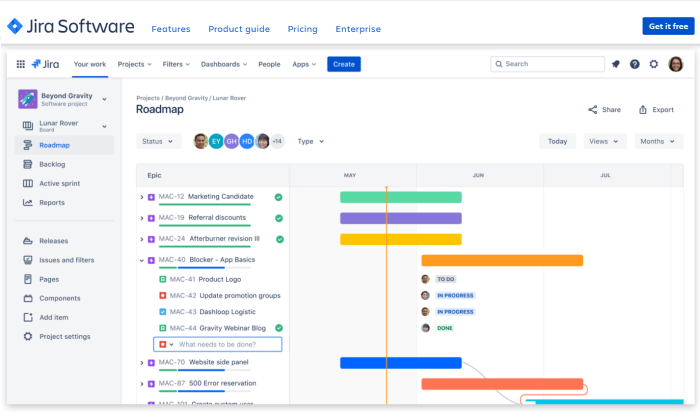
Disclosure: This content is reader-supported, which means if you click on some of our links that we may earn a commission.
Being on top of work feels so much better than the reverse.
A stakeholder asks you a third-decimal-place question about a future project. You nail it. The answer is ready and the evidence is two clicks away.
With the right project management software, it’s easier to operate at a high level.
It’s like wearing the right pair of shoes.
If you’ve never tried project management software, these free options are a great place to start.
And if you are using a frustrating tool, struggle no more.
These are the best free project management software options available right now.
Seriously, all of these products are free to use forever.
The Top 4 Free Options for Project Management Software
- Trello – Best for Lightweight Project Management
- Wrike – Best for Marketing Teams
- Jira – Best for Agile Teams
- ClickUp – Best for Large Organizations
How to Choose the Best Free Project Management Software for You
This stuff isn’t magic. You get out what you put in.
I like to think of project management software as a blank workspace waiting for a business to move in.
It gives every task a home so projects aren’t just roaming free-range across email chains, chat threads, post-it notes, and casual conversation.
One of the best parts about a free forever platform is that you actually have the chance to see what happens once you plug your business in.
Work with it for months and try a few different types of projects out.
I know freelancers and even small companies that have been able to get along just fine for years on a freemium plan.
So which one is for you?
Let’s walk through the core aspects of project management software and how they can have an impact.
Basic Structure
Every good project management tool is stupid simple. This is especially true for freemium plans.
But they’re not all organized in the same way. Some use traditional folders and lists, whereas others track tasks entirely on boards.
How will your team’s work fit into each space?
The better the fit between a platform’s basic structure and your team’s projects , the better they can use the software to get to where they want to go.
After all, with free project management software, you want it to fit your organizational processes, not change those to fit the freemium platform you choose.
Ideally, project management software will help evolve your business processes in a positive direction. But not overnight.
Collaboration
These platforms enable people to work together better by making business workflows transparent. Everyone can see the status of projects and tasks.
This puts people on the same page, all the time. And when changes need to be made, users can alert one another with comments or by tagging teammates. This draws the right attention to the exact point of the issue.
With less uncertainty, people are free to act instead of waiting on a long email chain to finally arrive at an answer.
Some platforms will keep a comment history associated with each individual task. Others will have an activity feed that logs updates made to the task.
These capabilities make it much easier for teams to know when a task is 100% done.
Scheduling
The tools I like let you assign users and due dates to tasks. Very simple, very helpful.
Whether you are building out on a board or a list, you can toggle views to see tasks displayed on a calendar.
Updating the task due date will update the calendar as well, keeping everyone on the same page.
With some of the more robust free options, like ClickUp, you can set dependencies to govern the schedule.
Reporting
Because it’s loaded with information about what teams are doing, reports generated by project management software provide a lot of insight.
I’m talking about measuring productivity, identifying trends, and staying under budget. This information can really help managers steer their teams productively.
Some of the options on this list, like Jira, have pre-built reports that are ready to go for any project.
Not all free project management software comes with reporting features.
Trello, for example, doesn’t provide anything out of the box. That said, you can tie in a third-party analytics platform to do the heavy lifting.
Automation
Automation in free project management software is limited, no doubt. But anyone can use it.
It’s just a taste of what these platforms can do, but the early exposure can pay dividends in the long run.
When it comes time to bump up into a higher tier, users are ready to take advantage of automation instead of being intimidated by these power features.
This isn’t a make-or-break it criteria, but if users find they can eliminate some busywork from their day, it might increase buy-in to the platform.
The Different Types of Free Project Management Software
There’s a stunning array of diversity to think about when you are looking at the straight-up best project management software out there.
When it comes to free forever plans, the field narrows.
There are really two types of free project management software out there:
- Board-based
- List-based
You’ll find some overlap, but understanding the differences between these types will help you find a solution built to fit your needs.
Free Board-Based Project Management Software
These products have an organizational hierarchy that goes something like this:
Team→Board→List→Card
Here’s a screenshot from Trello, one of the most popular board-based options in the world:

This is the board, which all members of the team can see. Each card is a task, and it is under the appropriate list.
With Trello and other board-based software, teams spend most of their time on the board. This involves going into tasks to add detail and check off complete tasks and potentially switching to calendar view to check bandwidth.
Does your current workflow map well to this cards-and-boards layout?
Free List-based Project Management Software
These products have an organizational hierarchy that goes something like this:
Team→Folder→List→Task
ClickUp is a great example of how a list-based product helps teams stay on track:
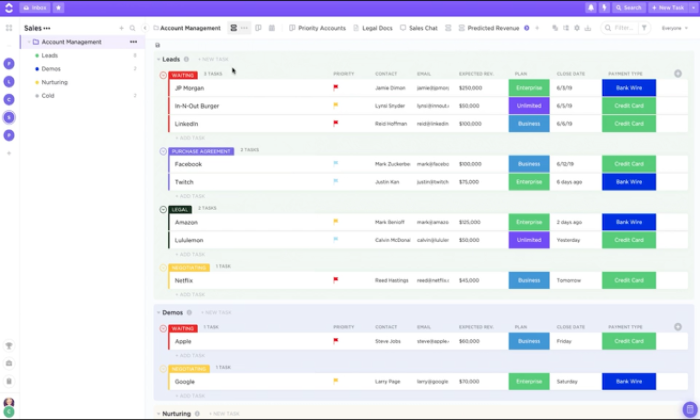
The team has their folders listed on the left. Very traditional. Each folder contains lists, which are broken down into tasks.
List-based software can make it easier for teams to stay organized than a board that gets cluttered. In ClickUp and other good options, the list is drag and drop, so it’s not any harder to use.
In Wrike, another list-based project management solution, you can even view your projects as a spreadsheet.
Looking at both types, there’s a lot of flexibility to view projects in different forms, like list, board, calendar, or table.
Because of this, it might seem like the boundary between these two is a little fuzzy.
From my perspective, though, flexible viewing does not always equal flexible managing.
Trello works great when you are building on a board. ClickUp works great when you are building on a list.
Sure, they can also do what the other does to some extent. I just think they work best when you are using them as designed.
And, since all of these products are free forever, it’s not going to break the bank to pilot one of each type and see what you and your team think.
#1 – Trello — Best For Lightweight Project Management
Trello is one of the most user-friendly project management options on the market. Maybe that’s why more than 1 million teams are using Trello around the world.
When I say user-friendly, I mean there is virtually zero learning curve to engaging with the product.
Drag. Drop. Click. Done.
Boards are made up of cards and lists. Clicking on any card brings up all of the relevant details, such as who’s responsible, what needs to get done, and when it must be done by.
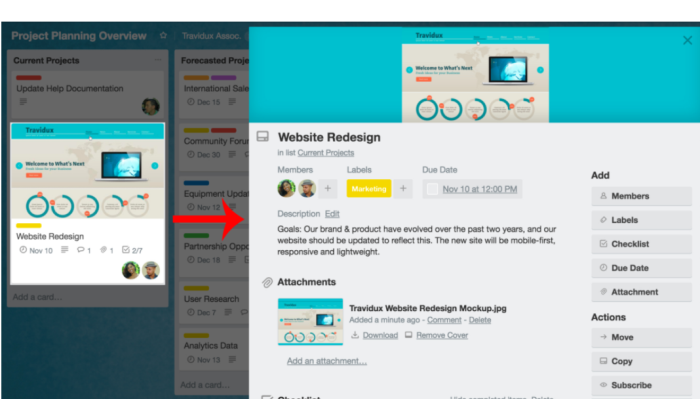
Obviously agile teams will dig the Kanban-style setup, but Trello is so basic (in a good way) that people can build out boards within whatever framework suits them best.
Staying on track in Trello is so easy, it’s almost fun.
Assign people to tasks and they’re notified instantly when changes are made. There’s a comment feed built into every task and team members can use @mentions to call out specific issues.
Users can switch from board to calendar view to see their tasks spread out week to week. They can also “watch” cards to which they are not assigned, something that is great for managers.
The Trello platform has two main power features.
There are Power-Ups, which let you tie in a third-party service. It could be a time tracker, a Gantt chart creator, or a collaboration tool like Slack.
And then there is Butler, an AI-service that finds repetitive tasks and helps you automate them. You can create buttons that kick off simple workflows, or schedule tasks to be created.
With Trello’s free version, you get:
- 10 boards per team
- Unlimited cards and lists
- The ability to add attachments to cards, up to 10 MB each
- Two-factor authentication
- One Power-Up per board
- 50 Butler commands per month
It’s incredibly easy to build what you need in Trello. There is still a lot of freedom to create the structure you need, but they also offer a range of templates for project management:

There’s also templates ready to go for HR, sales, support, and other departments.
Trello’s got you covered for lightweight project management. There’s definitely a ceiling when it comes down to what you can track on each board, even compared to other free project management software.
For a single team, though, managing a sales pipeline, content calendar, or something of similar scope is going to be a breeze.
#2 – Wrike– Best For Marketing Teams
Wrike is a really versatile project management platform with a free forever version for teams of up to five.
There are a few reasons why it works so well for marketing teams compared to some of the other best free project management software.
First off, the collaborative features are really well-developed.
You can store tasks within projects or folders. Teammates can add comments, tag colleagues with @mentions, and attach files directly to any task, folder, or project.
Okay, I hear you saying, “It sounds like some of the other free project management software.”
But, what makes Wrike so effective out-of-the-box for marketing teams is that email integration is included. Users can update, create, and prioritize tasks directly from their email.
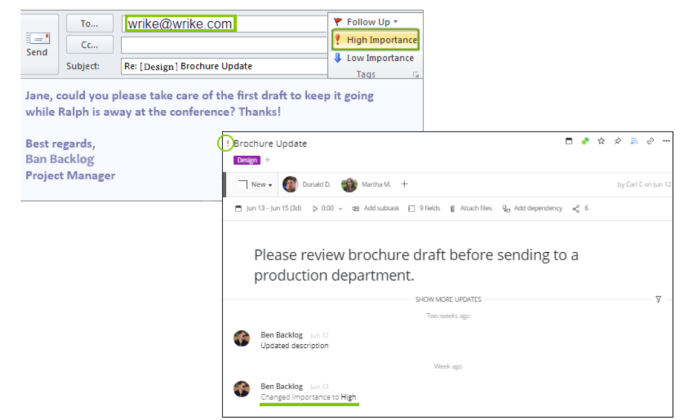
It’s great for your team, but you can also invite clients and contractors. These users are designated as Collaborators. Basically, you can share projects and plans without having to worry that external users will make serious changes.
Another useful feature for keeping track of marketing campaigns at scale is the Table View, which breaks out all tasks into a spreadsheet view:
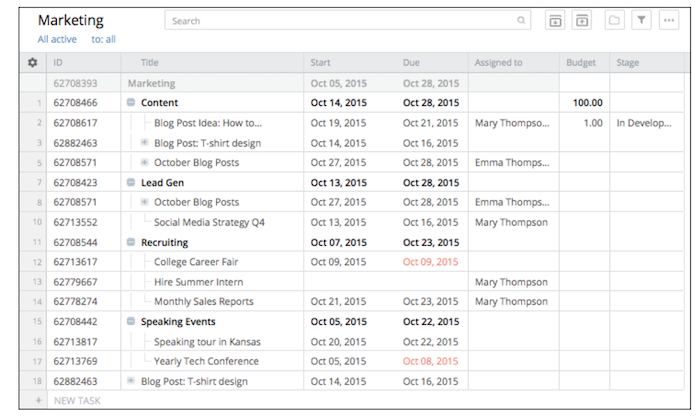
These and other time-saving features help marketing teams stay on track and save time.
The Real-time Activity Stream, for instance, provides users with a feed of all the updates and comments on projects they’re assigned. Users can quickly filter the activity stream to see the updates that matter most.
Some of the other nifty features included with the free version of Wrike include:
- Board view
- Drag-and-drop task management
- Mass edits
- Cloud storage integrations
- Microsoft 365 integration
- 2GB storage
- Mobile App
If Wrike ends up being a good solution, they’ve got paid plans that are tailor-made for marketing and creative teams.
Wrike for Marketers is a business-level project management software dedicated to helping teams across the company create on-brand experiences at scale. They offer a 14-day free trial so teams can get a sense of everything that comes with the premium platform.
Wrike for Marketers Performance takes the analytics and workflow automation to another level.
There are pre-built dashboards, advanced reporting features, data visualization tools, and integrations with an additional 400 apps.
For marketing teams, Wrike is an excellent choice. Their free project management software is enough for a team to get started, and their paid plans will take a company to the next level.
#3 – Jira — Best for Agile Teams
Jira is built from the ground up to serve teams that work within an agile framework.
The customizable task boards are ideal for Scrum and Kanban, but so is Trello.
What separates Jira in terms of working well for agile teams are the baked-in reporting and roadmap features.
For managing a single team, both these features are huge time-savers. They work behind the scenes to turn all the information on your boards into visual intelligence.
Roadmaps help you track the bigger picture by placing work on a timeline that clearly maps project dependencies.

Rather than a Gantt chart, which tracks outputs, a roadmap tracks outcomes, like solving customer problems. Work feedback, product vision, and goals into your roadmap, not just the deliverables, to get a better picture of long-term strategy.
Whether it’s a new product or sprint increment, roadmaps help teams connect their daily work to the team’s progress toward the overall goal.
There are also 12 standard agile reports available for any Jira project.
There’s nothing users have to do to configure these. Jira automatically takes your boards and cranks out really helpful reports for agile project management, like burndown charts, velocity charts, and sprint reports.
The free version of Jira comes with other helpful features for agile teams like:
- 10 users for one site
- Customizable workflows
- Automation
- Backlogs
- Apps and integrations
- 2GB file storage
- File sharing
- Business continuity and disaster recovery
A word about a few of these features. Since Jira is an Atlassian product (like Trello), there’s a really long list of apps and integrations that are going to work.
The customizable workflows and automation are definitely limited with the free version of Jira, but you can work many third-party tools into your processes.
With Jira, the deliberately agile design means that teams and leaders have to do less finagling to get the tools they need.
Backlogs, for instance, can be set up with other free project management software. In Jira, however, they are a dedicated feature that has been designed for backlog grooming and sprint planning.

Instead of spending time to configure the system, teams can start using Jira on day one.
Another helpful feature is that each task is assigned a unique key and ID. This is great for ticketing and bug-tracking.
Give their free forever version a shot and find out why so many agile teams depend on Jira.
#4 – ClickUp — Best For Large Organizations
ClickUp offers the most control and functionality in the free project management software category. It’s my pick for larger organizations for two reasons.
One, the free platform is generous enough to accommodate multiple teams. More than that, the simple structure is built to scale.
The number two reason is customizability. Each team can configure their workspace to suit their specific needs.
Let’s dig a little deeper into both these reasons.
The free version allows for five Spaces, each of which is enough to support an individual team. Spaces can hold up to 400 folders, which can in turn hold up to 100 lists.
Lists are where tasks live and ClickUp allows for unlimited tasks in every list. You can also create up to 100 custom fields for lists to track whatever is most important about each task.
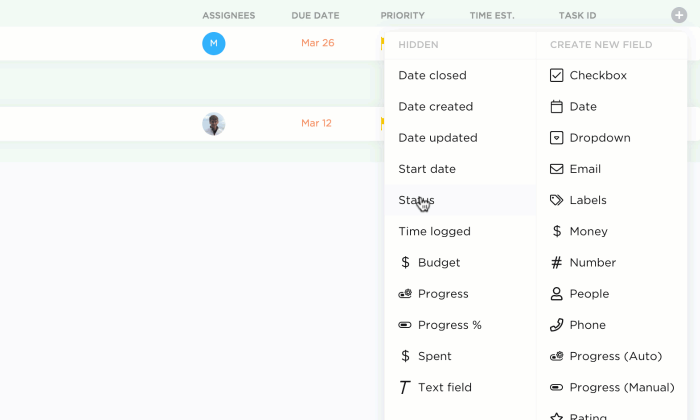
And it’s still super intuitive.
Everything is drag and drop and you can toggle between list, board, and calendar views. There’s even a “me” view that shows only tasks assigned to the user.
When it comes to tasks, this is where ClickUp’s customizability really shines.
Here’s a list of some of the things you can do within tasks
- Assign members to task
- Comment thread with @mentions
- Assign comments to members
- View activity feed
- Track time
- Add due dates
- Create checklists for sub-tasks
- Change status
- Set dependencies
- Move tasks to different folders
- Draft rich text task description
- Add attachments: docs, images, videos
Yes. I’m still talking about the free forever ClickUp plan. It’s almost like they are too generous.
To set dependencies, for example, users simply indicate that a task should wait on another task to start or block another task in the workflow from starting.
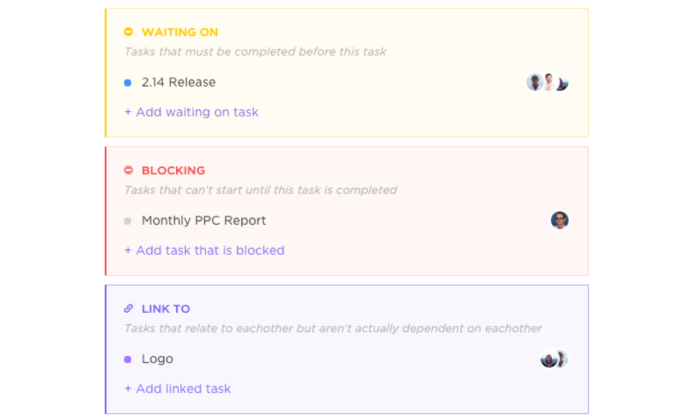
And because you can track dependencies and due dates, ClickUp’s free version provides 100 uses of their Gantt chart feature.
Honestly, I’ve barely covered half of what ClickUp can do.
It’s my top pick for larger organizations that want free project management software they can actually use.
Little things—like how every task in ClickUp has a unique ID—make staying organized at scale possible.
Plus, the hierarchy of spaces, folders, lists, and tasks is simple and flexible enough to work for just about any use case.
In the end, ClickUp really forces teams to stay organized as they build out. You can’t put a price on that.
Summary
If we take all the frosting off the cake, what we really have left is a simple real-time system that captures a team’s workflow.
Finding the right free project management software is about understanding how each platform accommodates the local needs of each team.
If you are just starting to explore project management software, the free version of Trello is a great place to begin. It takes no time to master and has enough functionality for teams to tackle lightweight projects.
For companies that need a little more power out of their project management solution, ClickUp is the best bet. The feature set is robust compared to other tools and it will work well across multiple teams.
On the marketing side, Wrike provides email integration, which I think is essential. That’s something that only comes with paid versions from other vendors.
In addition to that, both the internal and external collaborative features are rich. This makes it easier to interface with customers and coordinate behind the scenes.
Workplaces that subscribe to an agile methodology will find that Jira has been hand-crafted to suit their needs. The out-of-the-box reporting and deliberate design make it very attractive.
The post Best Free Project Management Software appeared first on Neil Patel.
from Blog – Neil Patel https://ift.tt/34YBgAK

No comments:
Post a Comment